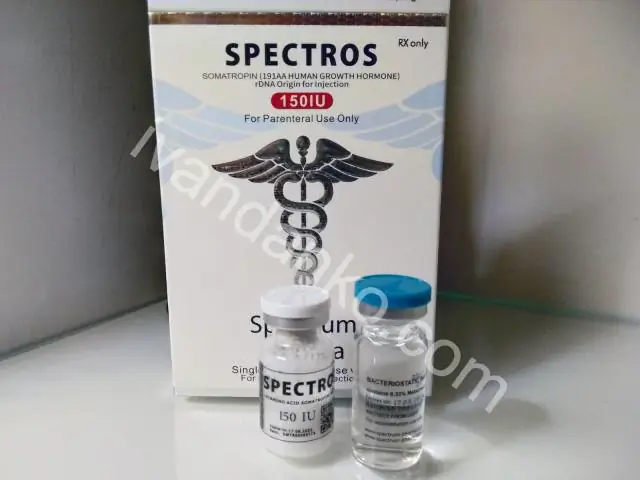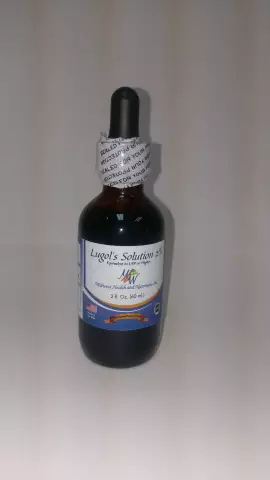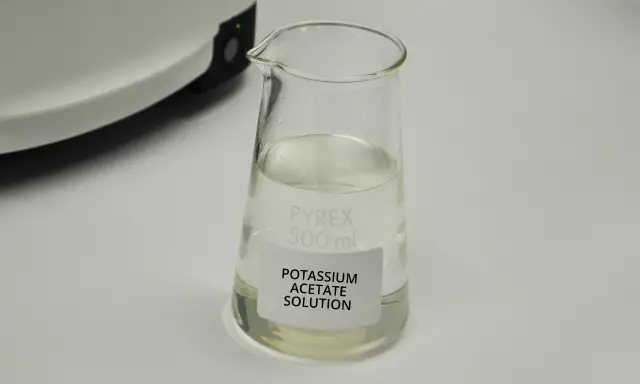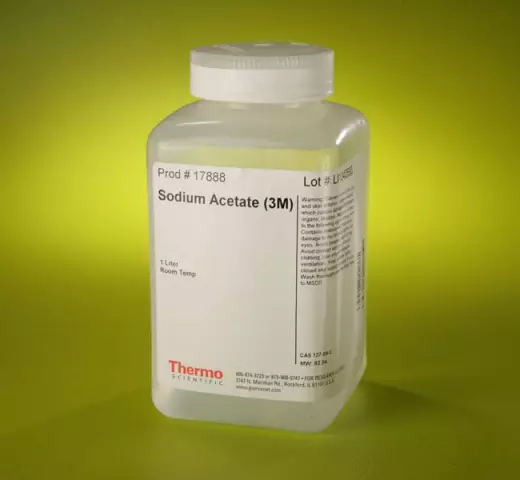- Author Rachel Wainwright [email protected].
- Public 2023-12-15 07:39.
- Last modified 2025-11-02 20:14.
Omnitrope
Omnitrope: instructions for use and reviews
- 1. Release form and composition
- 2. Pharmacological properties
- 3. Indications for use
- 4. Contraindications
- 5. Method of application and dosage
- 6. Side effects
- 7. Overdose
- 8. Special instructions
- 9. Application during pregnancy and lactation
- 10. Use in childhood
- 11. In case of impaired renal function
- 12. Use in the elderly
- 13. Drug interactions
- 14. Analogs
- 15. Terms and conditions of storage
- 16. Terms of dispensing from pharmacies
- 17. Reviews
- 18. Price in pharmacies
Latin name: Omnitrope
ATX code: H01AC01
Active ingredient: somatropin (Somatropin)
Producer: Sandoz, GmbH (SANDOZ, GmbH) (Austria)
Description and photo update: 2019-17-10
Prices in pharmacies: from 585 rubles.
Buy
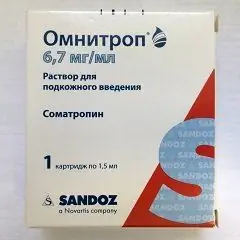
Omnitrope is a somatotropic drug. It is a recombinant growth hormone.
Release form and composition
The drug is available in the form of a solution for subcutaneous administration with a dosage of 3.3 mg / ml and 6.7 mg / ml, which is a slightly opalescent or transparent colorless liquid (1.5 ml each in transparent colorless glass cartridges, sealed with a rubber piston rod with one side and an aluminum cap with a rubber gasket on the other, in a contour package 1, 5 or 10 cartridges, in a cardboard box one contour package and a medical instruction for the use of Omnitrope).
Composition for 1.5 ml solution (one cartridge):
- active substance: somatropin - 5 mg (for a dosage of 3.3 mg / ml) or 10 mg (for a dosage of 6.7 mg / ml);
- auxiliary components: sodium hydrogen phosphate heptahydrate, sodium hydroxide, sodium dihydrogen phosphate dihydrate, poloxamer, phosphoric acid, water for injection; additionally for a dosage of 3.3 mg / ml - benzyl alcohol (preservative), mannitol; additionally for a dosage of 6.7 mg / ml - phenol (preservative), glycine.
Pharmacological properties
Pharmacodynamics
Somatropin, the active component of the drug, has a pronounced effect on the metabolism of proteins, carbohydrates and fats. In children with GH (growth hormone) deficiency, the Omnitrope acts on the epiphysis plates of the tubular bones, thereby stimulating the growth of skeletal bones in length. In both children and adults, the drug normalizes body structure by reducing fat and increasing muscle mass. Visceral adipose tissue is especially sensitive to the action of somatropin. Somatropin enhances lipolysis and reduces the supply of triglycerides to the body's fat depots. The drug increases the concentration of IGF-1 (insulin-like growth factor 1) and IRFSB-3 (protein-3, which binds insulin-like growth factor).
In addition to the effects listed above, the following properties of somatropin have been identified and demonstrated:
- fat metabolism: the drug activates LDL (low density lipoprotein) receptors in the liver, and also changes the profile of lipoproteins and lipids in the blood; in patients with GH deficiency, as a result of the use of somatropin, the concentrations of cholesterol, apolipoprotein B and LDL in the blood decrease;
- carbohydrate metabolism: Omnitrope increases insulin release, but fasting glucose usually does not change; in children with partial or complete loss of the function of the anterior lobe of the pituitary gland, hypoglycemia may develop on an empty stomach, and the introduction of somatropin makes it possible to reverse this condition;
- bone metabolism: with long-term treatment with somatropin in children with osteoporosis and GH deficiency, the mineral composition and density of bone tissue are normalized;
- water and mineral metabolism: with a lack of GH, the volume of extracellular fluid and plasma decreases; as a result of the use of the drug, both parameters are quickly normalized, since somatropin contributes to the retention of potassium, phosphorus and sodium in the body;
- physical activity: as a result of long-term substitution therapy with Omnitrope, muscle strength increases and physical endurance increases.
Somatropin also increases cardiac output, but the mechanism of this action remains unclear. It is believed that this effect of the drug is partly due to a decrease in peripheral vascular resistance.
Pharmacokinetics
The bioavailability of somatropin after subcutaneous administration is about 80% (it is the same for healthy individuals and patients with GH deficiency). With the introduction of Omnitrop at a dose of 5 mg, the maximum concentration of the drug in the blood of healthy volunteers was reached after 4 ± 2 hours and was 72 ± 28 μg / l.
The average elimination half-life of somatropin in adult patients with GH deficiency was approximately 25 minutes after intravenous administration and approximately 3 hours after subcutaneous administration.
In women and men, the absolute bioavailability of the drug after subcutaneous administration is the same.
There are no data on the effect of impaired renal, heart or liver function, as well as race and age, on the pharmacokinetics of somatropin.
Indications for use
In childhood, Omnitrope is prescribed for growth retardation caused by the following reasons:
- insufficient secretion of GH;
- Prader-Willi syndrome;
- Shereshevsky-Turner syndrome;
- low growth rates at the time of birth (if the available growth rates do not match a specific gestational age);
- chronic renal failure (if kidney function is reduced by more than 50%).
In adult patients, Omnitrope solution is used as replacement therapy for severe confirmed GH deficiency (acquired or congenital).
Contraindications
Absolute:
- emergency conditions (including as a result of acute respiratory failure, complications after surgical interventions on the abdominal cavity or heart, as well as multiple injuries due to accidents);
- malignant tumors (especially if there are signs of activity of a brain tumor);
- the presence of closed epiphyseal growth zones (when using Omnitrope to stimulate growth);
- the neonatal period (including premature infants), since the drug contains preservatives (benzyl alcohol or phenol);
- period of pregnancy and lactation;
- increased individual sensitivity to the main or auxiliary ingredients of the drug.
Relative (Omnitrope is used with caution):
- hypothyroidism (including thyroid hormone replacement therapy);
- increased pressure in the cranial cavity;
- diabetes;
- concomitant treatment with glucocorticosteroids.
Omnitrope, instructions for use: method and dosage
Omnitrope solution is administered subcutaneously, slowly. Frequency rate of application - once a day (preferably at night). To prevent lipoatrophy, it is recommended to regularly change injection sites.
Doses of the drug are selected individually. When choosing a dose, the body surface area or the patient's weight, the severity of the GH deficiency, and already in the course of treatment - the effectiveness of the therapy are taken into account.
Recommended doses of Omnitrope for children:
- insufficient secretion of GH: 0.7-1 mg / m2 of body surface or 0.025-0.035 mg / kg of body weight once a day. Treatment should be started as early as possible and continued until bone growth and / or puberty are closed. When the result is achieved, therapy can be stopped earlier than the specified time;
- Prader-Willi syndrome: Omnitrope is prescribed to children to increase growth rates and improve body composition at a dose of 1 mg / m 2 of body surface or 0.035 mg / kg of body weight once a day; the maximum daily dose is 2.7 mg. Somatropin should not be prescribed to children with almost closed growth zones in the epiphyses of the bones and those whose growth gain in a year was less than 1 cm;
- Shereshevsky-Turner syndrome: 1.4 mg / m 2 of body surface or 0.045-0.05 mg / kg of body weight once a day;
- growth disorders in children born with low growth rates for a given gestational age: 1 mg / m2 of body surface or 0.035 mg / kg of body weight once a day until the desired growth is achieved; if after the first year of treatment the increase in height was less than 1 cm, treatment with somatropin should be discontinued; discontinuation of therapy is also required in cases where the increase in height was less than 2 cm per year, closed epiphyseal growth zones are observed and it has been established that the bone age is more than 16 years (for boys) or more than 14 years (for girls);
- chronic renal failure, accompanied by growth retardation: 0.045-0.05 mg / kg of body weight once a day; if the growth dynamics is insufficient, you can increase the daily dose of Omnitrope; dose revision is possible no earlier than 6 months of therapy.
For adult patients with severe GH deficiency, it is recommended to prescribe Omnitrope for the purpose of replacement therapy in low initial doses - no more than 0.15-0.3 mg per day. In the future, depending on the serum concentration of IRF-1, the dose of the drug is gradually increased. In patients with a normal initial concentration of IGF-1, the dose is selected so that the level of IGF-1 is at the upper limit of the norm and does not go beyond two standard deviations from the mean. The maintenance dose of somatropin is selected individually. Usually it does not exceed 1 mg per day (or 3 IU per day). In men, the sensitivity to IRF-1 increases over time, but in women this effect is not observed, so women may require higher doses of Omnitrope. If this fact is not taken into account, then in patients, especially thosewho are simultaneously receiving estrogen replacement therapy, the dose of somatropin may be insufficient, and in male patients, on the contrary, the dose of the drug may be excessive. The optimum dose of Omnitrope should be monitored every six months.
In patients over 60 years of age, treatment begins with a starting dose of 0.1-0.2 mg once a day, and then it is gradually increased to the individual required. It is recommended to use Omnitrope in the minimum effective dose, which rarely exceeds 0.5 mg per day.
Side effects
In patients with GH deficiency, there is a deficit in the volume of extracellular fluid, which is quickly eliminated when somatropin is prescribed. In adult patients, due to fluid retention, side reactions such as peripheral edema, arthralgia, paresthesia, myalgia and limb stiffness are often observed. The severity of these side effects varies from moderate to moderate. Usually, adverse reactions develop in the first months of drug treatment and go away on their own or with a dose reduction. The likelihood of developing these phenomena depends on the age of the patient and the dose of Omnitrope. There are no reports of the development of such adverse reactions in children.
Side effects arising from the organs and systems of the body, when using the drug Omnitrope (classified as follows:> 1/10 - very often; from> 1/100 to 1/1000 to 1/10 000 to <1/1000 - rarely; <1/10 000 - extremely rare):
- digestive system: infrequently - pancreatitis (in children);
- endocrine system: rarely - type 2 diabetes mellitus;
- nervous system: often - a burning sensation and tingling sensation (in adults); infrequently - carpal tunnel syndrome (in adults), paresthesia (in children); rarely, benign intracranial hypertension;
- musculoskeletal system and connective tissue: often (in adults) - pain in muscles and joints, rigidity of the limbs; infrequently (in children) - muscle and joint pain, limb stiffness;
- the immune system: often - the formation of antibodies to somatropin (it has no clinical significance, since the binding capacity of such antibodies is very low);
- malignant and benign tumors, neoplasms of an unspecified nature: very rarely - leukemia (the incidence of this side effect is comparable to the incidence of leukemia in children with normal GH levels who do not receive somatropin);
- other reactions: often - peripheral edema (in adults), transient skin reactions at the injection site (in children); infrequently - peripheral edema (in children).
Overdose
Omnitrope overdose cases have not been reported.
It is assumed that acute overdose may first cause hypoglycemia and then hyperglycemia. Long-term overdose may be accompanied by symptoms and signs characteristic of an excess of human GH (gigantism and / or acromegaly, decreased serum cortisol levels, the development of hypothyroidism).
In case of intoxication, Omnitrope should be canceled and the necessary symptomatic treatment should be prescribed.
special instructions
Insulin resistance
Omnitrope can reduce insulin sensitivity, and in some patients, cause hyperglycemia, therefore, before using the drug, it is necessary to establish whether glucose tolerance is impaired. Type 2 diabetes mellitus during treatment with somatropin develops rarely and most often in patients with risk factors for this disease (family history, obesity, taking glucocorticosteroids, impaired glucose tolerance). In patients with diabetes mellitus during treatment with somatropin, it may be necessary to change the doses of hypoglycemic agents. In children at high risk of diabetes mellitus, a glucose tolerance test should be performed before starting therapy. In case of detection of diabetes mellitus, treatment with somatropin is prohibited.
Thyroid
During the period of Omnitrope therapy, thyroxine (T 4) is intensively converted to triiodothyronine (T 3), which leads to corresponding changes in the blood plasma. In healthy volunteers, the concentration of thyroid hormones usually remains within the normal range, but, despite this, there is a theoretical likelihood of clinical manifestation of subclinical hypothyroidism. However, patients who receive levothyroxine sodium as hormone replacement therapy may develop hyperthyroidism. Given the facts above, it is recommended to regularly monitor the function of the thyroid gland (after starting treatment with somatropin and at each change in the daily dose).
Adrenal function
Somatropin reduces the plasma concentration of cortisol, which is most likely due to an increase in hepatic clearance or the effect of the drug on carrier proteins. The clinical significance of these observations has not been precisely established, but glucocorticosteroid replacement therapy should be optimized before the appointment of Omnitrope.
Malignant tumors
In case of GH deficiency after anticancer treatment, it is necessary to pay attention to the possible symptoms of recurrent malignant tumor.
Increased intracranial pressure
In the event of vomiting and / or nausea, recurrent or severe headaches and visual impairment, an ophthalmoscopy is recommended to detect possible swelling of the optic nerve head. At the same time, it should be remembered that when the intracranial pressure rises, the edema of the optic nerve head does not develop immediately, that is, in its absence, intracranial hypertension cannot be excluded. If the diagnosis is confirmed, Omnitrope should be discontinued.
Resuming treatment with the drug after elimination of intracranial hypertension usually does not lead to a relapse. Nevertheless, it is recommended to establish monitoring of the patient for the timely detection of symptoms of hypertension.
Prader-Willi syndrome
In children with Prader-Willi syndrome, a low-calorie diet must be followed during treatment with somatropin. There have been isolated cases of death in patients with this disease who received somatropin. In each of these cases, the patient had at least one of the following risk factors: sleep apnea, unidentified respiratory tract infection, history of respiratory failure, and severe obesity. Before starting the use of Omnitrope, it is necessary to examine patients with Prader-Willi syndrome for the presence of respiratory infections, sleep apnea and upper airway obstruction. If symptoms of upper airway obstruction occur during treatment, the drug should be discontinued and an unscheduled examination of the patient by an ENT doctor should be performed.
With Prader-Willi syndrome, children often have scoliosis, which can progress with rapid growth, therefore, during treatment with Omnitrope, it is necessary to monitor for possible manifestations of scoliosis. Taking somatropin itself does not increase the risk of developing or the severity of scoliosis.
Growth impairment in chronic renal failure
Renal function before starting treatment should be no more than 50% of normal. Growth impairment is confirmed by tracking growth in dynamics during the year preceding therapy. During this time, the patient is prescribed conservative treatment, which includes monitoring nutritional status, hyperparathyroidism, and acidosis. Conservative therapy is continued with the start of the main treatment. If you have a kidney transplant, you should stop taking Omnitrope. There are no data on the size of the increase in growth when somatropin is prescribed to patients with chronic renal failure.
In patients with endocrine disorders, including GH deficiency, femoral epiphyseal displacement is usually more common than in the general population.
If lameness is detected during treatment with the drug, careful observation and additional clinical examination are required.
In children born with low growth rates for a given gestational age, all other possible causes of growth deficiency must be excluded before starting therapy. In addition, it is recommended that such children have regular blood glucose measurements.
Omnitrope at a dosage of 3.3 mg / ml contains benzyl alcohol as a preservative, so it should not be administered to newborns, in particular premature infants. Benzyl alcohol can cause anaphylactic and toxic reactions in children under 3 years of age.
Application during pregnancy and lactation
Omnitrope is contraindicated during pregnancy and breastfeeding.
If taking somatropin during lactation is necessary, breastfeeding should be discontinued.
Pediatric use
In children, Omnitrope is used according to indications (except for newborns, including premature babies, for whom the drug is contraindicated, since it contains preservatives benzyl alcohol and phenol).
With impaired renal function
Somatropin is used in patients with chronic renal failure, in which the functional activity of the kidneys before starting treatment is no more than 50% of normal.
Omnitrope is contraindicated in kidney transplantation.
Use in the elderly
The experience of using Omnitrope in elderly patients (over the age of 60) is limited. In such patients, treatment is started with lower doses.
Drug interactions
It is assumed that the prescription of somatropin increases the clearance of drugs that are metabolized in the liver with the participation of isoenzymes of the cytochrome P 450 system, especially CYP3A4, namely, cyclosporine, anticonvulsants, glucocorticosteroids and sex hormones. As a result of this interaction, the plasma concentrations of the listed agents may decrease, but the clinical significance of this effect has not yet been established.
Glucocorticosteroid drugs inhibit the stimulating effect of Omnitrope on growth processes. The efficacy of somatropin (in terms of final growth) may be altered by the concomitant use of other hormones (eg, estrogens, gonadotropin, thyroid hormones, and anabolic steroids).
Analogs
Omnitrop analogs are Dinatrop, Jintropin, Genotropin, Rastan, Norditropin Simplex, Norditropin NordiLet, Humatrop, Sizen.
Terms and conditions of storage
Keep out of the reach of children. Store at + 2 … + 8 ° С. The solution must not be frozen.
Shelf life: for cartridges 5 mg / 1.5 ml - 2 years; for cartridges 10 mg / 1.5 ml - 1.5 years.
Terms of dispensing from pharmacies
Dispensed by prescription.
Reviews about the Omnitrope
There are not so many reviews about the Omnitrope, but almost all of them are positive. The drug is well tolerated, practically does not cause side effects. The growth rates are very good. The injections are painless. Both specialists and patients warn that during treatment it is necessary to be monitored by an endocrinologist and regularly take a number of tests.
Omnitrope price in pharmacies
The price of Omnitrope in the form of a solution for subcutaneous administration with a dosage of 3.3 mg / ml (1 cartridge of 1.5 ml in a package) is 2600-3900 rubles. The drug in the form of a solution for subcutaneous administration with a dosage of 6.7 mg / ml (1 cartridge of 1.5 ml in a package) can be bought for 4300-4930 rubles.
Omnitrope: prices in online pharmacies
|
Drug name Price Pharmacy |
|
Omnitrope Pen 10 1 pc. 585 RUB Buy |
|
Omnitrope 6.7 mg / ml solution for subcutaneous administration 1.5 ml 1 pc. 4200 RUB Buy |

Maria Kulkes Medical journalist About the author
Education: First Moscow State Medical University named after I. M. Sechenov, specialty "General Medicine".
Information about the drug is generalized, provided for informational purposes only and does not replace the official instructions. Self-medication is hazardous to health!

